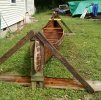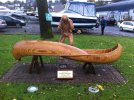You are using an out of date browser. It may not display this or other websites correctly.
You should upgrade or use an alternative browser.
You should upgrade or use an alternative browser.
Misshapen Hull
- Thread starter Bannersix
- Start date
MGC
Scrapmaker
Thanks for adding a picture of the hull.
You are not the first person with this problem. Proper storage is very important.
It is very hard to remove a "set" from a canoe, but it is sometimes possible.
I removed most of a "hog" from a canoe that had sat on horses for too long. I never thought that it could be done but the results were surprisingly good.
Here is a thread that is chock full ideas, offers to burn my canoe, pictures of my attempt and the results:

 forums.wcha.org
forums.wcha.org
You are not the first person with this problem. Proper storage is very important.
It is very hard to remove a "set" from a canoe, but it is sometimes possible.
I removed most of a "hog" from a canoe that had sat on horses for too long. I never thought that it could be done but the results were surprisingly good.
Here is a thread that is chock full ideas, offers to burn my canoe, pictures of my attempt and the results:
It's hogged
I'm working on a canoe that is hogged. It looks like the classic saw horse set. Has anyone ever successfully and permanently corrected a hogged hull? I saw those pictures of a Huron bathing in an aluminum canoe... It looks like that one was corrected a bit....but what happens to it when it gets...
Last edited:
1905Gerrish
Loves Old Maine canoes
I have tried very diligently before with minimal results, but the effort made me feel better when someone criticizes it. It's a tough job. Expectations should be better but not perfection unfortunately.
Worth Gretter
LOVES Wooden Canoes
My canoe project (early 1900s Maine guide canoe, unknown builder) has about 1/2 inch of hogging. It presently has all ribs and planks repaired, and inner and outer gunwales in place. So basically a complete canoe without canvas. I hung it upside down in my garage over the winter, suspended from the two quarter points. Then I added an additional cross bar under the center of the canoe, and tightened those ropes so the center support held all the weight. After 4 months of hanging like that, there was no change in the shape of the canoe. None.
So my takeaway is that something more drastic would be needed, such as the ideas earlier in this thread. But for now I will just live with it and focus on completion.
So my takeaway is that something more drastic would be needed, such as the ideas earlier in this thread. But for now I will just live with it and focus on completion.
Treewater
Wooden Canoes are in the Blood
Here's a boat that had a serious twist in the hull. I soaked it for two days, just left the water running. I went constantly outside to wet down eveything. After I was satisfied it was thoroughly soaked I built these jigs. You can see my level on the back. Trial and error. More art than science. It worked. I wouldn't hesitate to do the same to your boat. Anyone object?
Attachments
Treewater
Wooden Canoes are in the Blood
Interesting what 100% moisture and constant pressure does to wood. We all understand steam to bend ribs which is a rapid process. House roofs that never dry, staying saturated, sag enormously over the years.The other extreme I saw in Chaco Canyon North New Mexico. Native Americans used wood lintels for doorways. Long after they abandoned Chaco Canyon the lintels held stone for hundreds of years. Try that in Puget Sound Washington... Ten, twenty years at most and wood lintels collapse. The very process that created a hogged hull can reverse itself by moisture and turning the canoe over and judicious application of support and weight.
MGC
Scrapmaker
A twist in the hull in the bow or stern is a problem that is not too hard to fix.
How the boards join the stem and where the decks are positioned has a very direct effect on how straight the hull is. If the stem is only twisted side to side (not twisted Rushton elm style with curves going both left and right) you can generally get the canoe to re-true by removing the planking and repositioning the stem to center. Once you have it in place, reattaching a few pieces of planking should hold it in place. At that point you can rejoin the rails and replace the decks before putting the rest of the planking on.
You may need to massage those boards to either shorten or lengthen them (replace) to accommodate the changed location.
You use a very similar process when you build from scratch.
How the boards join the stem and where the decks are positioned has a very direct effect on how straight the hull is. If the stem is only twisted side to side (not twisted Rushton elm style with curves going both left and right) you can generally get the canoe to re-true by removing the planking and repositioning the stem to center. Once you have it in place, reattaching a few pieces of planking should hold it in place. At that point you can rejoin the rails and replace the decks before putting the rest of the planking on.
You may need to massage those boards to either shorten or lengthen them (replace) to accommodate the changed location.
You use a very similar process when you build from scratch.
Rob Stevens
Wooden Canoes are in the Blood
Worth Gretter
LOVES Wooden Canoes
Beautiful sculpture Rob! Where is it?
Where is it?
I'm not Rob but this is from the Kip Marina at Inverkip, Grennock, Scotland. It was shared on the sailing group in Facebook by Holger David Kelm with "oh oh" as the caption in 2018.
Benson
Worth Gretter
LOVES Wooden Canoes
Thanks!
Worth Gretter
LOVES Wooden Canoes
I need to revisit my comment of March 31 above. After using a heat gun to go after the last of the fiberglass resin on the hull, I started attacking the resin in the planking gaps. It turns out that all the planks were basically edge-glued together! So that may explain why I had no luck in my attempt to correct the hogging.



